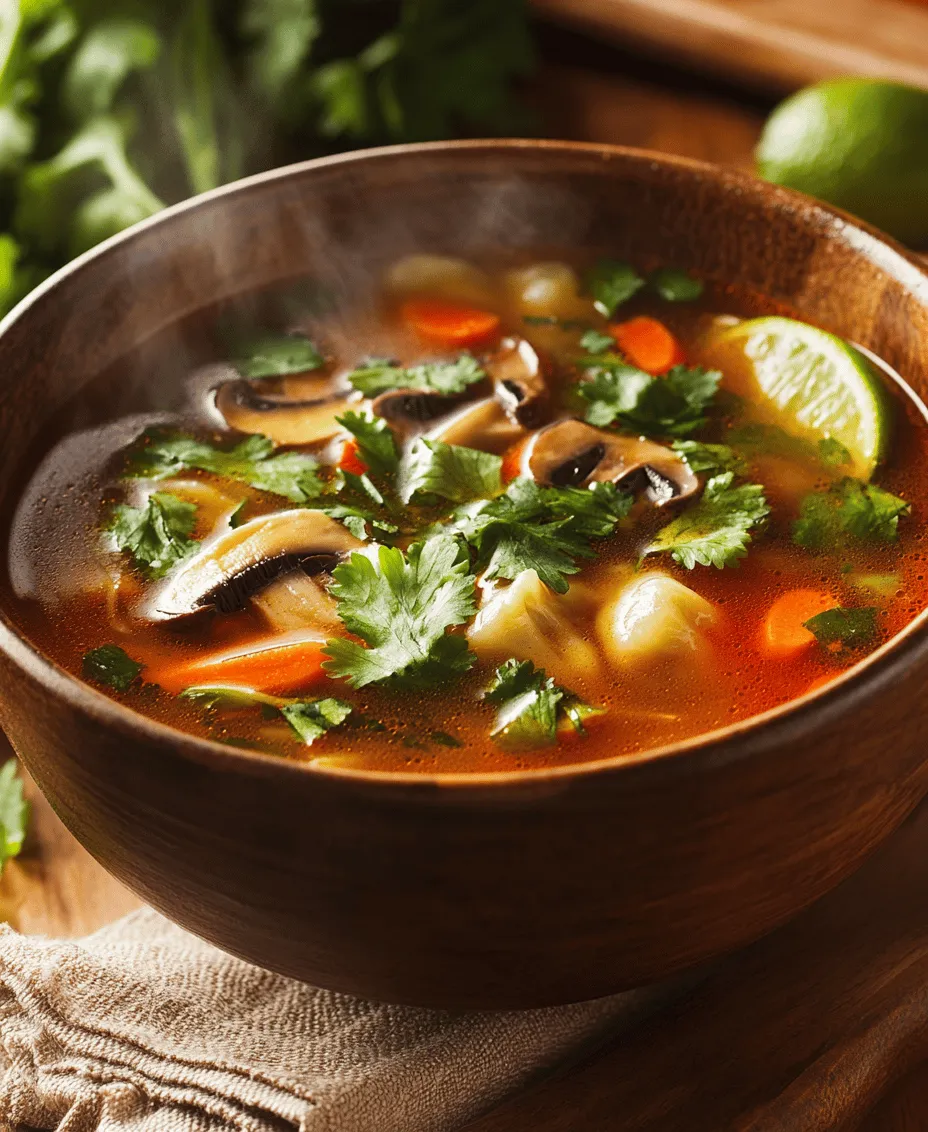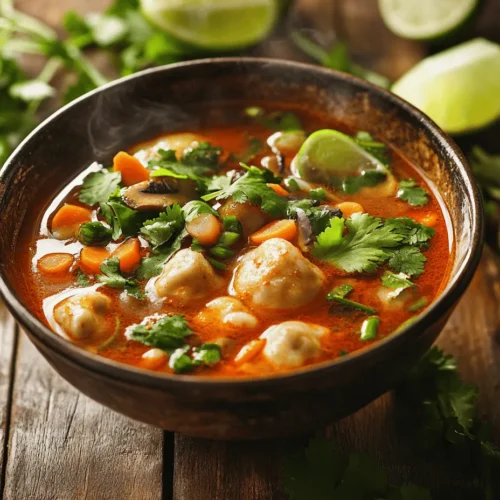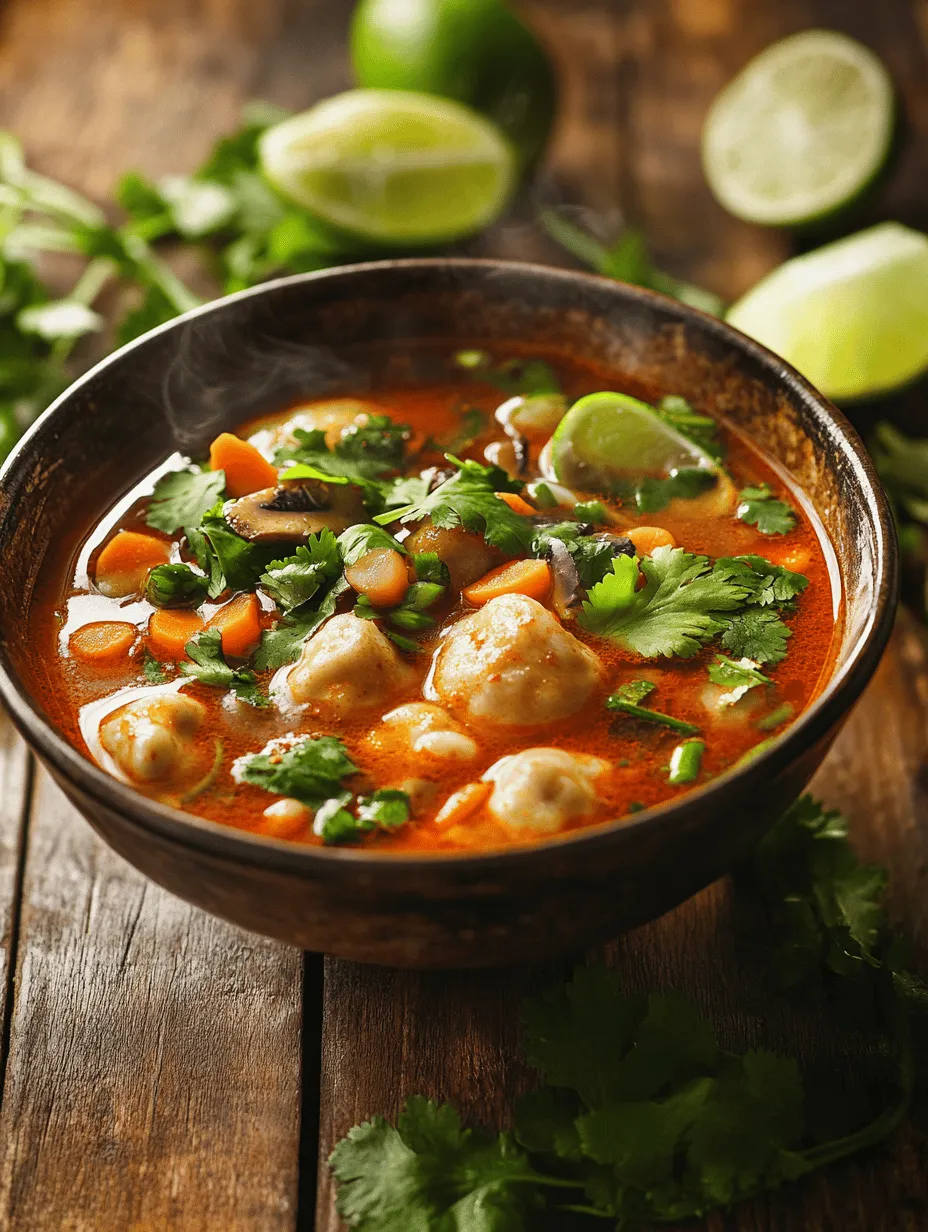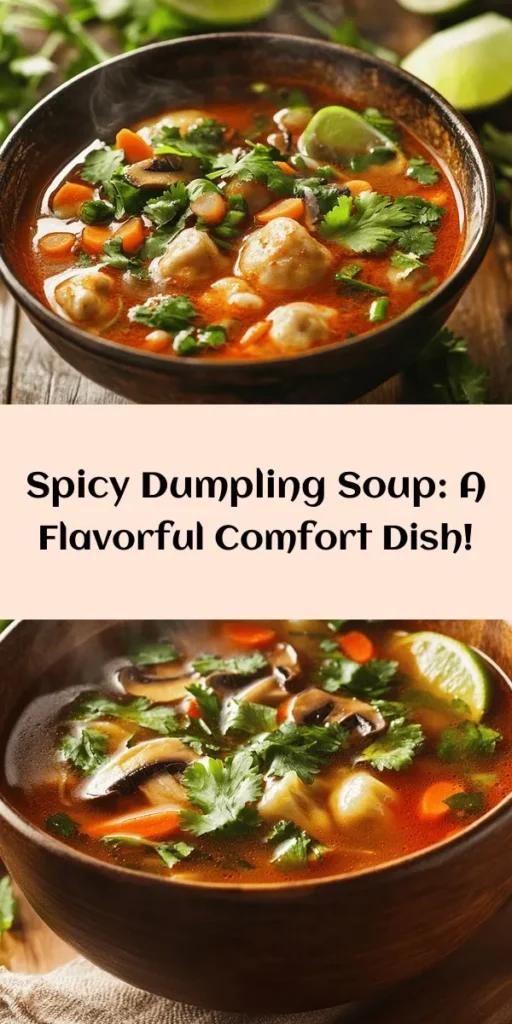Introduction
Dumpling soup is a cherished dish that embodies comfort, flavor, and warmth in every bowl. A staple in many Asian cuisines, it combines savory dumplings with a rich, aromatic broth, creating a dish that warms the soul and satisfies the senses. The beauty of making authentic dumpling soup at home lies not just in its deliciousness but also in the excitement of crafting something special from scratch. This recipe invites you to explore the delightful balance of spices and fresh ingredients that come together to form a hearty, spicy soup that is sure to become a favorite in your household.
One of the most compelling aspects of this recipe is its versatility. While the traditional dumpling soup is often prepared with ground pork, this recipe accommodates various proteins, allowing for customization based on dietary preferences or availability. Each component, from the dumplings to the broth, is infused with spices and flavors that create a memorable dining experience.
Understanding Dumpling Soup
The history of dumpling soup can be traced back through various cultures, each adding its unique twist to this comforting dish. In China, for instance, dumplings are a symbol of prosperity and are often served during the Lunar New Year to celebrate good fortune. Similarly, in Eastern European cuisines, dumplings are frequently found in soups, serving as a hearty addition to cold-weather meals. These cultural contexts highlight the universal appeal of dumpling soup as a staple comfort food, transcending borders and generations.
In addition to its cultural significance, dumpling soup offers numerous nutritional benefits. The primary ingredients—dumplings filled with protein, fresh vegetables, and a flavorful broth—combine to create a balanced meal. Ground pork or alternative proteins provide essential amino acids, while the addition of scallions, ginger, and garlic not only enhances the flavor but also contributes to overall health. Ginger is known for its anti-inflammatory properties, while garlic is celebrated for its immune-boosting benefits.
Dumplings themselves are a beloved comfort food across various cultures, often associated with family gatherings and shared meals. Their soft texture and savory filling evoke feelings of nostalgia and warmth, making them an ideal centerpiece for a cozy dinner. The combination of the dumplings and the spicy broth elevates this dish, making it a perfect choice for any occasion, whether it’s a casual weeknight dinner or a special gathering.
Ingredients Breakdown
To create the perfect authentic spicy dumpling soup, you’ll need to gather a selection of fresh, high-quality ingredients. Each component plays a significant role in building layers of flavor.
Dumpling Ingredients
1. Ground Pork (or Alternative Proteins): The star of the dumplings, ground pork brings a rich, savory flavor that forms the foundation of the filling. If you prefer a leaner option, ground chicken or turkey can be substituted, or even a plant-based protein for a vegetarian version.
2. Scallions: These green onions add a fresh, mild onion flavor that brightens the dumpling filling. Not only do they enhance the taste, but they also add a pop of color, making the dish visually appealing.
3. Ginger: Fresh ginger provides a zingy warmth that complements the meat beautifully. Its aromatic qualities also contribute to the dumpling filling’s overall depth of flavor.
4. Garlic: A must-have in many savory dishes, garlic adds a pungent and slightly sweet flavor that elevates the overall taste profile. It also brings a myriad of health benefits, making your dumplings not only delicious but also nutritious.
5. Soy Sauce: This umami-rich condiment is essential for seasoning the filling. It adds a depth of flavor that balances the richness of the pork and the freshness of the vegetables.
6. Sesame Oil: A small amount of sesame oil not only enhances the flavor with its nutty aroma but also contributes healthy fats to the dish.
7. Rice Vinegar: This ingredient adds a subtle tanginess that rounds out the flavors and helps to balance the richness of the dumplings.
8. Chili Oil: For those who love spice, chili oil is a game-changer. It adds a kick to the filling and sets the stage for the spicy broth.
Soup Ingredients
1. Broth: The base of your dumpling soup can be made with either chicken or vegetable broth. Chicken broth provides a rich flavor, while vegetable broth offers a lighter option without compromising taste. Homemade broth is preferred, but store-bought versions can also work in a pinch.
2. Baby Bok Choy: This tender leafy green adds a subtle sweetness and a pleasing crunch to the soup. It cooks quickly and retains its vibrant color, enhancing the overall presentation.
3. Shiitake Mushrooms: These mushrooms bring an earthy flavor to the broth and pair beautifully with the dumplings. They also offer a unique texture that contrasts with the softness of the dumplings.
4. Carrots: Sliced carrots add a touch of sweetness and a bright color to the soup. They also provide additional nutrients, making the dish even more wholesome.
5. Cilantro: Fresh cilantro brings a burst of freshness to the soup and balances out the spiciness. Its aromatic qualities enhance the overall flavor profile of the dish.
6. Lime Wedges: Finally, lime wedges offer a zesty kick when squeezed over the soup just before serving, brightening the flavors and adding a refreshing finish.
Step-by-Step Guide to Preparing Dumplings
Now that we have a clear understanding of the ingredients and their roles, it’s time to dive into the preparation of the dumplings. Making dumplings from scratch may seem daunting, but with a step-by-step approach, you’ll find the process both enjoyable and rewarding.
Preparing the Filling
1. Mix the Ingredients Thoroughly: Begin by combining the ground pork (or chosen protein), chopped scallions, minced ginger, minced garlic, soy sauce, sesame oil, rice vinegar, and chili oil in a large mixing bowl. It’s crucial to mix these ingredients thoroughly to ensure that the flavors meld together. Use your hands or a spatula to incorporate all the ingredients evenly. The mixture should be well-blended but not overworked; you want to keep the texture light and airy.
2. Taste and Adjust: Before you start filling the dumpling wrappers, taste a small spoonful of the filling. This is your chance to adjust the seasoning if necessary. If you prefer a spicier filling, feel free to add more chili oil or a sprinkle of red pepper flakes. Remember that the flavor will develop further once cooked, so be mindful of how much seasoning you add.
3. Prepare the Dumpling Wrappers: If you’re making your own dumpling wrappers, roll out the dough to about 1/16-inch thickness and cut into circles using a cookie cutter or a glass. If you’re using store-bought wrappers, make sure they are kept covered to prevent them from drying out while you work.
4. Fill the Dumplings: Place about a tablespoon of the filling in the center of each dumpling wrapper. Be careful not to overfill, as this can cause the dumpling to burst during cooking. Moisten the edges of the wrapper with a touch of water, fold it in half to create a half-moon shape, and press the edges together to seal. For a decorative touch, you can pleat the edges by pinching small sections together, which also ensures a tight seal.
Cooking the Dumplings
Once your dumplings are filled and sealed, they can be prepared in various ways: steamed, boiled, or pan-fried. Each method brings a unique texture to the dumplings, so choose the one that appeals most to you.
1. Steaming: If you opt for steaming, place the dumplings in a bamboo steamer lined with parchment paper to prevent sticking. Steam for about 10-12 minutes over boiling water until the filling is cooked through.
2. Boiling: To boil the dumplings, bring a large pot of salted water to a gentle boil. Carefully drop the dumplings in batches, ensuring not to overcrowd the pot. Cook for 5-7 minutes or until they float to the surface and are cooked through.
3. Pan-Frying: For a crispy texture, you can pan-fry the dumplings. Heat a tablespoon of oil in a skillet over medium heat. Arrange the dumplings in the pan and fry for about 2-3 minutes until the bottoms are golden brown. Then, add a splash of water to the pan and cover to steam the dumplings for about 5 minutes until cooked through.
With the dumplings prepared, you are now ready to move on to creating the flavorful broth that will bring this authentic spicy dumpling soup to life. The combination of your delicious homemade dumplings and a rich, aromatic broth will make for an unforgettable dish that embodies comfort and satisfaction.
Stay tuned for the next part of this recipe, where we will delve into crafting the perfect broth and assembling your spicy dumpling soup for a truly delightful culinary experience.

Wrapping Dumplings
The process of wrapping dumplings may seem daunting at first, but with practice, it can become an enjoyable part of your cooking routine. Begin by taking a circular dumpling wrapper and placing it in the palm of your hand. Using a spoon, add a generous teaspoon of your prepared filling to the center of the wrapper. Be careful not to overfill, as this can make sealing difficult.
Techniques for Sealing Dumplings Properly
Sealing dumplings is crucial for preventing them from bursting during cooking. Start by moistening the edge of the dumpling wrapper with a little water; this will help create a seal. Fold the wrapper in half to create a semicircle, pinching the edges together to remove any air bubbles. For extra security, you can use one of several techniques to seal the dumpling. The most common method is the pleating technique: pinch the edges together and form small pleats along the curved edge. This not only secures the filling but also adds an attractive design to your dumplings.
Variations in Folding Styles for Presentation
Each region has its own folding style for dumplings, which can add a personal touch to your dish. For instance, the classic Chinese jiaozi can be folded into various shapes, such as the simple half-moon, or more intricate shapes like the ‘swan’ or ‘ear’ folds. Experiment with these styles to find one that suits your aesthetic preference or matches the occasion. Presenting beautifully folded dumplings can enhance the overall dining experience.
Cooking Methods for Dumplings
Once your dumplings are beautifully wrapped, it’s time to decide on a cooking method. The two most popular methods are steaming and pan-frying, each with its own unique benefits.
Steaming vs. Pan-Frying: Pros and Cons of Each Method
Steaming: This method involves cooking dumplings in a bamboo or metal steamer over boiling water. Steamed dumplings are typically softer and retain more moisture, making them tender and juicy. However, they may lack a crispy texture that some diners crave.
Pan-Frying: Also known as “potstickers,” this method involves cooking dumplings in a hot pan with a bit of oil until they are golden brown on the bottom. Then, add water to the pan and cover it to steam the dumplings. This dual cooking method provides a delightful contrast in texture—crispy on the outside and soft on the inside.
Tips on Ensuring Dumplings Are Cooked Perfectly
Regardless of the cooking method you choose, a few tips can ensure your dumplings are cooked to perfection. First, avoid overcrowding the cooking vessel, as this can lead to uneven cooking. For steaming, ensure the water does not touch the dumplings and that they have enough space to expand. For pan-frying, keep an eye on the water level; you want enough to steam but not so much that it makes the dumplings soggy. Lastly, always test one dumpling by cutting it open to check that the filling is cooked through and the wrapper is tender.
Crafting the Perfect Soup
Now that your dumplings are ready, let’s focus on crafting the perfect soup to accompany them. The broth is the heart of your dumpling soup, and it deserves careful attention.
Preparing the Broth
Start by heating a large pot over medium heat, adding your choice of broth—chicken, vegetable, or beef—depending on your flavor preference. For an authentic taste, consider making your broth from scratch using bones and aromatics. If you’re short on time, store-bought broth works well too.
Importance of Simmering for Flavor Infusion
Allow the broth to come to a gentle simmer. Simmering is vital, as it allows the flavors to meld beautifully. This process can take anywhere from 15 minutes to an hour, depending on how deep you want the flavors to be. For added complexity, toss in ingredients such as ginger, garlic, and scallions during the simmering process.
Adding Vegetables
Once your broth is infused with flavor, it’s time to add vegetables. Choose a mix of colorful, seasonal vegetables for both taste and presentation. Popular options include bok choy, mushrooms, and carrots.
Timing for Each Vegetable to Maintain Texture and Taste
Add heartier vegetables, like carrots, first, as they take longer to cook. After a few minutes, add more delicate vegetables like bok choy and mushrooms. This staggered approach ensures that each vegetable retains its unique texture and flavor profile, enhancing the overall dish.
How to Adjust Spice Levels in the Broth
If you’re aiming for a spicy broth, consider adding chili oil, fresh chopped chilies, or a splash of hot sauce. Start with a small amount, taste, and adjust to your desired level of heat. For those who prefer a milder soup, keep the spice minimal and allow diners to add their own heat at the table.
Combining Dumplings and Soup
Once the broth and vegetables are ready, it’s time to combine them with the dumplings. Gently add the cooked dumplings to the pot, ensuring they don’t break apart. Allow them to warm through for about 2-3 minutes in the broth. Stir carefully to avoid any mishaps.
Techniques for Merging the Two Components Without Breaking Dumplings
To merge the dumplings and soup without damaging them, consider using a slotted spoon to lower them into the broth gently. Avoid stirring aggressively; instead, gently swirl the pot to combine the flavors.
Serving Suggestions
Now that your Authentic Spicy Dumpling Soup is complete, it’s time to serve and savor this delightful dish.
Presentation Ideas for a Beautiful and Appetizing Soup
Presentation can elevate your dining experience. Use deep bowls to showcase the vibrant colors of the soup and ingredients. Garnish with fresh herbs like cilantro or green onions for a pop of color and additional flavor. A drizzle of chili oil on top not only enhances the aesthetics but also adds an extra kick.
Pairing Options: What to Serve Alongside the Soup
Consider pairing your dumpling soup with a side of pickled vegetables or a light salad. These sides can balance the hearty nature of the soup and add a refreshing contrast. For a more substantial meal, serve with steamed rice or a simple stir-fried vegetable dish.
Seasonal Variations or Adaptations for the Recipe
This recipe is versatile, making it perfect for seasonal adaptations. In the fall, consider adding pumpkin or squash to the broth for a sweet note. During summer, fresh herbs and lighter vegetables can brighten the dish. You can also experiment with different dumpling fillings, such as seasonal greens or seafood, to keep things interesting throughout the year.
Conclusion
Making Authentic Spicy Dumpling Soup at home is a rewarding experience that brings warmth and flavor to your dining table. From the satisfaction of hand-wrapping dumplings to the delightful aroma of simmering broth, each step is an opportunity to connect with the culinary traditions that inspire this dish.
The joy of enjoying a warm, flavorful bowl of soup is unparalleled—each spoonful is a comforting reminder of the love and effort you’ve put into creating it. Don’t hesitate to experiment with flavors and ingredients to personalize your soup. Whether you prefer it spicy or mild, with vegetables or without, the possibilities are endless. Gather your family and friends, and share the love of homemade dumpling soup that is sure to warm hearts and bellies alike.



